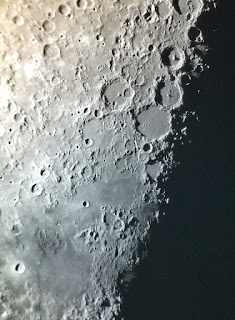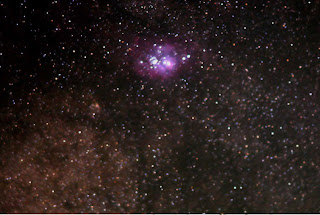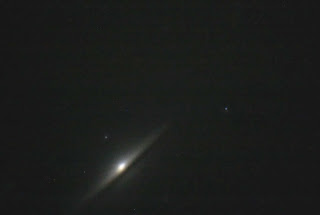12-23-2014:
Observed Lovejoy Q2 this morning using 10x50 binoculars and my 114 mm
reflector (450 mm FL, 18 mm eyepiece). Head of comet was very visible,
but I couldn't see the tail. Observation was about
12:15 am this morning.
Nolan Olson
12-31-2014:
Hi Wescott,
Happy New Year. I've been looking for Comet
Lovejoy for a while now and got excited to read that Nolan had spotted
it. Last night I went out again with my 11X80 binoculars and found it
right where the chart said it would be. It is not hard to miss, if
you're looking in the right place for it. It has quite a large coma but
no tail showing. Articles from my Sky and Telescope app showed that it
has been loosing its tail lately due to solar wind turbulence. Anyway,
I thought it would be a good New Years Eve activity to get a photo of
it. So despite a moon, 4 days from full, about 10 degrees away from the
comet's position and -10 degrees air temperature, I bundled up and
spent 1 hour in our back yard.
Attached is the
picture. I shot it with a Canon 20D DSLR at prime focus thru my 8"
Newtonian reflector. I set it at 3200 ISO for 10 seconds. I tried to
get on the IFAS blog but still couldn't get it to work for me. It seems
that computers are this old dinosaurs' worst enemy. Maybe you can do
it .
Thanks. Ron Pugh
1-1-2015:
Hi Wescott, I went out last night and found the comet quickly with
binoculars than looked at it with a 4 inch reflector. Nice coma on the
comet.
Jim
E
Observed it again about 10 minutes ago. Between the Moon and my
neighbor's deck light it was a challenge, but I saw it in both 10x50
binos and 114 mm reflector. I'm using Sky Safari to locate the
position. I'm also looking out my bedroom window - its cold out there
and I'm not going out!! No tail visible.
Nolan Olson
I just saw the comet too with my 20x60 binoculars. I didn't see a tail
either. It's kind of nestled in a parallelogram of relatively bright
stars. I just took Rigel down - catty-corner southwest-ish and spotted
it. It's brighter than I thought it would be and I thought I saw some
coma...but I do not see a tail.
Wescott F.
1-7-2015:
Got a good view of the comet before the clouds rolled in...despite it
being above a street lamp. It is a Blurry blob with a bright central
core. Subtle V-like structure. I swear I saw a small streaming tail with
averted vision...off and on. The v-like structure lends to what appears
to be a diffuse v-like tail that follows behind it. At one point a
satellite zoomed by the comet in the eyepiece. It was very small in size
compared to the comet (about the size of the comet's central core).
That gave me perspective on the size of the comet. It's far away, but it
must be very large.
By the way, I was viewing the comet with a 10 inch Dob and 18mm and 35mm eyepieces.
Happy Viewing!
Wescott F.
I just looked at it about a half hour ago and saw pretty much what you
saw. I too believe that with averted vision I could see tail.
Nolan Olson


































